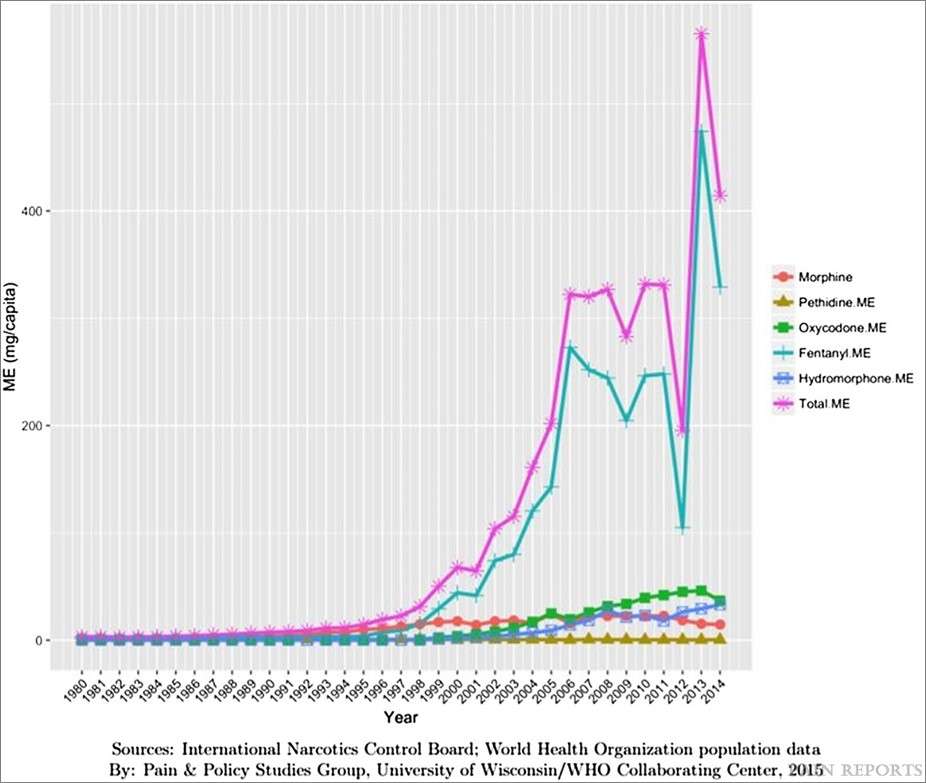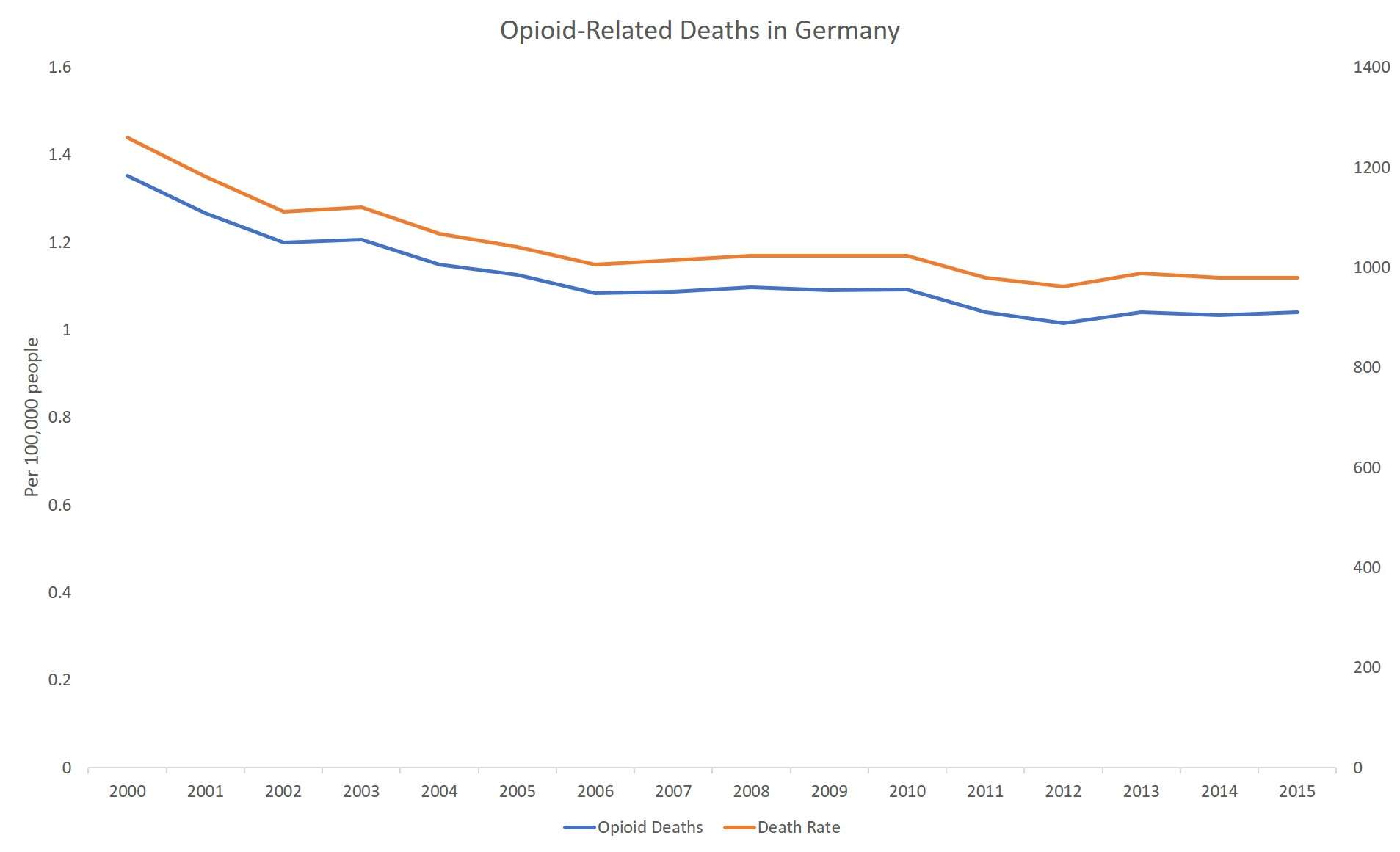As Opioid Prescriptions Surged in Germany, Opioid Addiction Held Steady, While Opioid-Related Deaths Fell
The data reinforce the point that there is no straightforward relationship between pain pill consumption and overdoses.

Contrary to the conventional narrative of the "opioid crisis," it is clear from U.S. data that there is no straightforward relationship between narcotic analgesic prescription rates and deaths involving those drugs, or between the volume of analgesics prescribed and the incidence of misuse or addiction. A recent study sheds further light on this issue, finding that "the number of persons addicted to opioids in Germany has hardly changed over the past 20 years," notwithstanding a sharp increase in opioid prescriptions that began in the 1990s.
Here is a chart showing the volume of opioids prescribed by German doctors, measured in morphine milligram equivalents per capita, from 1980 through 2014:

That comes from a 2017 article in the journal PAIN Reports. The newer study, published last March in Deutsches Arzteblatt International, estimates that in 2016 there were 166,294 "opioid-addicted persons in Germany." The researchers add that "comparisons with earlier estimates" indicate the number was about the same two decades before then, prior to the dramatic increase in opioid prescriptions. In other words, a large increase in consumption of narcotic pain relievers did not lead to a surge in addiction, whether to those drugs or to illicit opioids such as heroin.
What's more, OECD data compiled by J.J. Rich, a policy analyst at the Reason Foundation (which publishes this website), show that deaths involving licit and illicit opioids did not rise in Germany either. In fact, both the number of deaths and the death rate declined during the same period when prescriptions were climbing.

"There are signs of an opioid epidemic in Australia and Canada, but not in Germany," the authors of the 2017 PAIN Reports study concluded after looking at data from those three countries, all of which have seen big increases in opioid prescriptions during the last two decades. According to the OECD data, total opioid-related deaths fell in Australia from 2000 through 2006, then rose from 2007 through 2015, when the number was about the same as it was in 2000. In Canada, opioid-related deaths rose steadily from 2000 through 2012, then fell for the next three years. Yet in Germany, opioid-related deaths were declining or steady throughout that period.
What makes Germany special? Its regulations and guidelines, as described in the PAIN Reports study, seem pretty similar to those in Australia and Canada. One notable difference in prescribing guidelines is the daily dose at which "particular caution" is recommended, which was lowest in Australia and highest in Canada, with Germany in the middle. The study notes that "fentanyl patches are the most frequently prescribed strong opioids in Germany," and such products may be less appealing to nonmedical users than pills that can be swallowed or crushed and then snorted or injected.
But it seems clear that other factors are at work, including social and cultural conditions that make addiction more likely or less likely. "The US leads the developed world in per capita opioid-related overdose deaths, while Germany's overdose rate is among the lowest in the developed world," notes Phoenix surgeon Jeffrey Singer, a senior fellow at the Cato Institute, who brought both of these studies to my attention. "Germany's overdose rate has been essentially unchanged for most of this century. Opioids were considered responsible for just under 800 overdose deaths in 2016, compared to more than 42,000 deaths in the US that year."
The vast majority of those opioid-related deaths involved heroin or illicit fentanyl. The U.S. has a population four times as big as Germany's and an opioid problem more than 50 times as big.
There are also significant drug policy differences between the two countries. "Unlike the US, Germany has embraced harm reduction strategies for the treatment of substance use disorder and non-medical drug use for decades," Singer writes. "These strategies include safe injection facilities, needle exchange programs, medication assisted treatment and heroin assisted treatment, and distribution of test strips and naloxone."
Even if the U.S. copied German harm reduction policies, drug use would still look different in the two countries, because it is influenced by many variables beyond the substances themselves or the policies aimed at controlling them. But those policies can make drug use more dangerous or less dangerous, depending on the priorities of the people who formulate and execute them.
Editor's Note: As of February 29, 2024, commenting privileges on reason.com posts are limited to Reason Plus subscribers. Past commenters are grandfathered in for a temporary period. Subscribe here to preserve your ability to comment. Your Reason Plus subscription also gives you an ad-free version of reason.com, along with full access to the digital edition and archives of Reason magazine. We request that comments be civil and on-topic. We do not moderate or assume any responsibility for comments, which are owned by the readers who post them. Comments do not represent the views of reason.com or Reason Foundation. We reserve the right to delete any comment and ban commenters for any reason at any time. Comments may only be edited within 5 minutes of posting. Report abuses.
Please to post comments



Repeal the unconstitutional Controlled Substances Act.
Of, but if we did that, the Peepul might get up to all KINDS of un-taxable naughtiness!
By and large the biggest problem in the US was the government implying to doctors that they would be prosecuted for their patients' use or abuse of opioids. Rather than working with patients to address or even just manage an addiction, "recommendations" (in the mafioso sense of the word) of how much opioid use was acceptable became bright lines where Doctors understood they were safe from prosecution. And so they stopped prescribing pain pills and their patients instead turned to black market alternatives- which are now the biggest cause of death in the country.
Instead of accept this basic fact, the media and legislators are instead turning on the companies that manufacture opioids and the makers of illegal alternatives. Once again the government and its enablers seek to use government force to fix a problem they created.
Are you aware that less than 1% of all chronic pain patients become ADDICTED? Unless they already had substance abuse issues, in which case they would be using regardless.
You also seem unaware of the SOARING suicide rate among Veterans, the disabled, & any other group of chronic pain patient.
In one small county, 5 people over the age of 65 "OD'd" in 3 days...the conclusion....addicts are now Sr. Citizens.
Now who would want to get rid of veterans, the disabled, on disability & veteran's benefits? And WHY?
" POPULATION REDUCTION FOR SUSTAINABILITY" is what the government said. In the 1993 G8 UN summit in Rio.
A LOT went into this document about " sustainability" but none of it has been implimented, although driving chronic pain patients to suicide in droves & putting amphetamines into heroin & fentanyl analogues (that's what's in it when tested & why illegal drugs are killing so many, not a OD, a killer mixture) would kill off the addicts & unproductive people pretty quickly....effectively reducing the population, reducing the amount of money being paid to said population, so what if they served in the military? They aren't useful NOW!, & getting rid of all undesirables.
This document has been around since 93 (when Purdue brought oxycontin out & the gov didn't care, look it up) & is online for anyone to read...they know no one WILL read it & even if they did, what are they going to do about it?
Well, yes: Germany has an aging population (the third oldest population, compared to the US at number 61), so a lot of the increase in opioid prescriptions is likely for terminally ill old people; Germany's insurance system is stingy when it comes to prescription drugs; Germany doesn't have Mexico on its border or Mexican drug cartels or cartel members crossing its borders willy-nilly; German culture is illiberal and anti-individualistic; and getting packages from Chinese distributors into Germany is a major administrative hassle. Those are some of the differences that actually matter. Harm reduction strategies? Not so much.
Also, how much of the heroin and fentanyl problem is a black problem? I'm disappointed nobody broke down the statistics by race, unless they already knew that wasn't contributory.
The "why" is not "the Black" it is "the Poverty."
Welcome to what happens after centuries of institutionalized racism. It you want people to have middle class values, you should not have prevented them from getting access to the government subsides that created the White middle class:
http://citeseerx.ist.psu.edu/viewdoc/download?doi=10.1.1.587.5383&rep=rep1&type=pdf
. . . In the present study we test the racial invariance hypothesis regarding the impact of changes in poverty on race-specific violent crime rates in predominately white and predominately African American neighborhoods in Cleveland, Ohio. . .
. . . The results indicated that reductions in poverty were associated with reductions in violent crime rates in both predominately white and predominately black neighborhoods. Consistent with the racial invariance hypothesis suggested by the social disorganization and anomie perspectives, the effect of changes in poverty on changes in violent crime was statistically indistinguishable for the two racial groups. The results from our longitudinal analysis were also consistent with those of existing cross-sectional neighborhood level studies in this area. . .
Furthermore, if you want to play the "crime statistics" game, one should point out that the more than 50,000 Whites a year killing themselves with opiate overdoses, is greater than the entire number of traditional homicides in America:
The data is crystal clear that poverty itself does not produce violence.
In no way does that show that the widespread violence and dysfunctions in African American populations are due to poverty.
Traditional American and European middle class values are the rejection of any kind of government handouts; that kind of value system is what produces wealth in a population.
On the other hand, African Americans were making rapid economic progress until the late 1960's. It was the massive government interventions and anti-poverty programs that halted that progress and produced the dysfunctional, violent, and impoverished communities we see today.
Have you been to Germany? How do you know what harm reduction policies they have? Everything you've said comes straight out of the media.
This is the US, where anyone can, & does, believe anything they want.
This must be fake news, since all (woke) people know that:
1. Drug corporations are evil (as are all profit-seeking enterprises).
2. Doctors are mercenaries in the pocket of big Pharma, and thus also evil.
3. People have no independent agency and any outcomes are the fault of evil forces (see points 1 and 2).
or
Its true and proof of how superior socialized medicine can be.
LOL❤❤✌✌
"Germany's overdose rate has been essentially unchanged for most of this century. Opioids were considered responsible for just under 800 overdose deaths in 2016, compared to more than 42,000 deaths in the US that year."
Shyeah, no shit. 800 deaths is called "Wednesday" here.
"These strategies include safe injection facilities, needle exchange programs, medication assisted treatment and heroin assisted treatment, and distribution of test strips and naloxone."
I have to assume that it's the WAY they're rolling out these programs that are different, because we have all of these things here and the problem is getting worse. As you note, Opioid deaths decreased in Canada up to about 2015. Insite was introduced ~2011-- during a time when opioid deaths were already dropping. Deaths continued their decline after that, but then rose sharply. The blame was put on Fentanyl.
Wow. Do you think the media is telling the truth there?
Even for the USA 42k deaths is not a lot considering its population, and ODs go up every year, not since untreated pain was addressed in the 90's. Considering 250-400k medical error deaths per year in the United States, and who knows how many disastrous or bad outcomes there are, ...I'd have to say health care is the devil, not opiates. That said we now need as much authority to self-diagnose and self-treat with any and all substances legal.
...And those CDC ODs fail to separate opiate only, mix drug cocktails with alcohol, prescription opiate only, and suicide with an opiate, etc. Prescription opiate only ODs? We are see around 500 (five-hundred), some suicides when they heard their PAIN MEDICINE was going to be cut off.
Exactly, it's unlikely that 42k deaths are caused by opioids only. Usually it's adding alcohol or other drugs that cause an overdose. And more than 3/4 of all opioid deaths are because of illicit fentanyl, not from so-called overprescribing.
I can tell you I need pain management for a gross " medical mistake".
People tend to overlook these stats & claim the "US HAS BEST HEALTHCARE SYSTEM IN THE WORLD".
Yet I know 3 people, one of them a Dr., who left the country for surgery. And many more I'm not related to in any way.
So - - -
The feds are full of it again?
Damn, whodathunkit?
We now know beyond any possible contradiction that there is no relationship in the US between rates of prescribing versus rates of overdose-related mortality. Published CDC data reveal that the demographics of pain and addiction are almost entirely separate and always have been. Seniors over age 55 are prescribed opioids for pain three times more often than youth under age 19. But seniors have the lowest rates of overdose related deaths in any age group -- rates that have been stable for 20 years. Youth have rates of opioid overdose that are six times higher than Seniors and have skyrocketed in the same period.
America does have a major opioid "crisis". But prescriptions and doctors didn't cause it. The real causes are socioeconomic: unemployment due to automation of manual work, widening income inequality and structural poverty have hollowed out America's communities and destroyed families, rendering people vulnerable to aggressive marketing of street drugs. There is no quick fix for this problem without major realignment of tax policy and investment in infrastructure redevelopment.
"Unlike the US, Germany has embraced harm reduction strategies for the treatment of substance use disorder and non-medical drug use for decades," Singer writes. "These strategies include safe injection facilities, needle exchange programs, medication assisted treatment and heroin assisted treatment, and distribution of test strips and naloxone."
What do Conservatives rant and rave about whenever someone in the sane party, aka Democrats, advocates for "safe injection facilities, needle exchange programs"?
Welcome to reaping what you have sown since Nixon's racist War on Drugs.
Have you read what Nixon's people said about that? I wish I had the link! They admitted to ulterior motive blah blah blah. His administration, to be clear.
As to 1), if you work for decades to destroy the reputation of an industry, you have no grounds for surprise if the industry comes to be run largely by scalawags. All the people who care for their reputation have jumped ship.